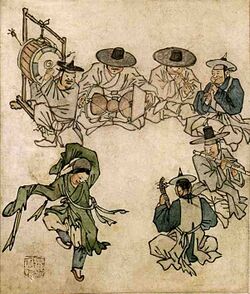Engineering:Korean drum
From HandWiki
Short description: Family of percussion instruments

In the picture titled "Dancing boy" (무동:舞童), several types of Korean drums are depicted.[1]
Korean drums play an important part in traditional Korean music, ranging from folk music[2] to royal court music. There are a wide variety of shapes and sizes, for use both in accompanying other instruments and in special drumming performances.[3]
In the traditional Korean classification of instruments, drums are grouped with the hyeokbu (혁부, 革部), or instruments made with leather. A notable class of these leather drums are Korean barrel drums.
History
During the Joseon period, many types of drums were used for the royal court music, including the janggu, jwago, yonggo, gyobanggo, jingo, jeolgo, nogo, and others. Among these, the janggu was also used for folk music, and later became the most commonly used drum used in Korean music.[4]
Types
- Buk (hangul: 북) - Double-headed shallow barrel drum used in folk music and played with one stick or one hand and one stick; varieties of buk are used in pansori, pungmul, and samulnori
- Janggu or Janggo (hangul: 장고 or 장구; hanja: 杖鼓 or 長鼓) - A double-headed hourglass-shaped drum generally played with one stick and one hand
- Galgo (hangul: 갈고; hanja: 羯鼓) - Double-headed hourglass-shaped drum similar to the janggo but played with two sticks and thinner drum heads; sometimes called yanggo or yangjanggo; no longer commonly used [1]
- Jingo (hangul: 진고; hanja: 晉鼓) - Largest barrel drum
- Jeolgo (hangul: 절고; hanja: 節鼓) - Barrel drum
- Jwago (hangul: 좌고; hanja: 座鼓) - A barrel drum in a wooden frame
- Geongo (hangul: 건고; hanja: 建鼓) - Huge barrel drum
- Yonggo (hangul: 용고; hanja: 龍鼓) - A barrel drum with a dragon painted on its shell; used in daechwita
- Eunggo (hangul: 응고; hanja: 應鼓) - Barrel drum suspended from a frame
- Sakgo - (hangul: 삭고; hanja: 朔鼓) - A long barrel drum suspended from a wooden frame
- Gyobanggo (hangul: 교방고; hanja: 敎坊鼓) - Flat drum suspended from a frame
- Junggo (hangul: 중고; hanja: 中鼓) - Flat drum suspended from a frame; similar to the gyobanggo but larger
- Sogo (hangul: 소고; hanja: 小鼓) - A small hand-held drum
- Nogo (hangul: 노고; hanja: 路鼓) - A set of two drums pierced by a pole
- Nodo (hangul: 노도; hanja: 路鼗) - A set of two small drums on a pole, which is twisted to play; used in ritual music
- Yeongdo (hangul: 노도; hanja:靈鼗) - Four drums on a pole, which is twisted to play; used in ritual music
- Noedo (hangul: 뇌도; hanja: 雷鼗)) - six small drums hung in a frame; used in ritual music
- Noego (hangul: 뇌고; hanja: 雷鼓) - Three small barrel drums on a pole, which is twisted to play; used in ritual music
- Do (도) - single pellet drum on a pole
Gallery
- A South Korean Republic of Korea Air Force playing a pungmul-buk
See also
- Traditional Korean musical instruments
References
- ↑ "Error: no
|title=specified when using {{Cite web}}" (in Korean). Empas / EncyKorea. http://100.empas.com/dicsearch/pimage.html?s=K&i=237666001&en=237666&p_i=&a_i=&e=1. - ↑ "Error: no
|title=specified when using {{Cite web}}" (in Korean). National Folk Museum of Korea. Archived from the original on 2005-11-23. https://web.archive.org/web/20051123112609/http://www.nfm.go.kr/data/full.cgi?v_kw_str=&v_db=1&v_doc_no=00000822&opt_s=1. - ↑ "Information of Traditional Korean Music". Archived from the original on 2008-07-05. https://web.archive.org/web/20080705071737/http://ailab.kyungpook.ac.kr/kmd/korea_music.htm. Retrieved 2008-09-11.
- ↑ "Error: no
|title=specified when using {{Cite web}}" (in Korean). Empas / EncyKorea. http://100.empas.com/dicsearch/pentry.html?s=K&i=237379&v=45.
- The New Grove Dictionary of Music and Musicians, 2nd ed. S.v. "Puk," by Robert C. Provine.[2]
- Jang Sa-hun (장사훈) (1969). "각종 북의 명칭과 사진 자료" (in Korean). Korean Musical Instruments (韓國樂器大觀). Korean Musicological Society / Cultural Heritage Administration. ISBN 89-7096-140-2. http://www.snupress.com/book/book_view.asp?isbn=89-7096-140-2. Retrieved 2008-09-11.
- Kang Han-yeong (강한영) (1976) (in Korean). Pansori. 세종대왕기념사업회.
Bibliography
- Samguk Sagi
- Goryeosa
- Book of Sui
- Akhak Gwebeom
External links
- Buk page[yes|permanent dead link|dead link}}] from NCKTPA site
Video
- Video showing sori-buk used in pansori
- Video showing pungmul-buk used in samulnori
- Video showing yonggo used in daechwita[yes|permanent dead link|dead link}}]
 |






